Network discovery tools help admins find devices, make maps of the network, keep track of devices, control who can use them, and manage the network better.
If you don't know what devices are on your network or how they're connected, it's hard to fix problems when things go wrong. Having a good network discovery tool is key for understanding what's happening on your network and keeping it secure. Whether you run a small business or a large corporation, this guide will help you find the right tool to effectively discover and manage your network devices.
Here is our list of the best network discovery tools:
- Datadog NPM: This is a powerful network performance monitoring tool that can be leveraged to track all network assets and gather performance metrics. A 14-day free trial is available on request.
- PRTG Network Monitor: Offers a solid foundation for network discovery, particularly for organizations with simpler network needs.
- SolarWinds NPM: A great choice for organizations seeking a comprehensive network discovery and performance monitoring solution.
- NetBrain: Goes beyond traditional network discovery tools, offering a comprehensive solution for visualizing, managing, and automating hybrid networks.
- WhatsUp Gold: This network discovery tool monitors and maps everything in your entire networked infrastructure. A free download is available on request.
- Atera: A cloud-based RMM platform that comes with a built-in network discovery feature. A free trial is available on request.
- Intermapper: Stands out for its strong focus on visual network discovery and mapping. A free 30-day trial is available on request.
- Nmap: Has earned a reputation as a powerful and versatile free and open-source network discovery tool.
- Spiceworks: Provides a free and user-friendly network discovery solution for smaller networks or those on a budget.
- Open-AudIT: Offers a good balance of network discovery, asset tracking, and reporting functionalities at no cost.
The best network discovery tools
Methodology used for our selection
In selecting our best network discovery tools, a combination of factors were considered to provide a well-rounded list. Some factors include:
- Functionality: The list incorporates tools with a variety of features, including basic discovery functionalities, such as ping sweeps and device identification, to more advanced features like vulnerability scanning, network mapping, and automation capabilities. We also considered popular network discovery tools that are widely recognized in the IT industry.
- Open-source vs. commercial options: We included fully commercial, commercial with free version, and open-source options to cater to users with varying budget constraints and technical skill sets.
- Addressing different network sizes: The list includes tools suitable for small to medium-sized networks and larger, complex networks.
- User experience: We considered the user-friendliness of the tools, recognizing that some users might be network administrators with extensive technical knowledge while others might have more basic IT needs.
- Positive reviews and reputation: These are generally well-regarded network discovery tools with positive user reviews and industry recognition.
It's important to note that this list is not exhaustive, and there are many other network discovery tools available. The most suitable tool for you will depend on your specific requirements and priorities.
1. Datadog NPM
Datadog NPM automatically discovers and collects metrics from various network devices. Users can leverage the platform to take inventory of their network hardware, access a complete list of devices, and search for specific devices based on parameters such as IP address and location.
Key features:
- Network inventory management: Provides a complete inventory of all network hardware, making it easy to manage and track devices.
- Network monitoring: It automatically discovers and collects metrics from a wide range of devices while allowing you to view stats on any interface, on any device, on any network.
- Visualizing network performance: Automatically discovers and maps devices, and provides a comprehensive view of SNMP device and network traffic data.
- Cloud-native and hybrid environment support: Works effectively in cloud and on-premise deployments.
Why do we recommend it?
Unlike some competitors focused solely on network devices, Datadog NPM visually maps application dependencies, highlighting how different services rely on each other's network communication. I found this to be crucial for troubleshooting performance problems stemming from application interactions.
Who is it recommended for?
Datadog NPM is suitable for modern organizations, especially those with complex cloud-native or hybrid environments, that require in-depth network traffic visibility, application dependency mapping, and seamless cloud platform integration.
Pros:
- Network discovery: Allows you to take inventory of all your network hardware and access statistics or gather metrics for any of them.
- Integration with discovery tools: Datadog NPM can integrate with other network discovery tools you might already be using, and Datadog NPM can then focus on monitoring traffic between these discovered devices and services.
- AI and machine learning: Leverages AI/ML for anomaly detection and proactive identification of potential network issues.
Cons:
- Learning curve: Using Datadog NPM effectively might require familiarity with network performance monitoring concepts and the Datadog platform.
2. PRTG Network Monitor
PRTG Network Monitor, primarily known for network monitoring, offers built-in network discovery functionalities that can be a valuable asset for managing your IT infrastructure. Its auto-discovery feature automatically scans your network segments using protocols like Ping. It identifies devices and creates basic sensors to monitor their health and availability.
Key features:
- Inventory management: Discovered devices are added to the PRTG inventory, providing a centralized view of your network components.
- Centralized alerting: Customize alerts and notifications centrally, receiving them via email, SMS, push notification, and other channels.
- Distributed monitoring: Monitor multiple locations and networks from a single, centralized platform.
- Support for common technologies: Utilize various technologies including SNMP, WMI, Packet Sniffing, Flow, SSH, and more for acquiring network usage data.
Why do we recommend it?
It offers a solid foundation for network discovery, particularly for organizations with simpler network needs. I noted its ease of use, automatic sensor creation, and integration with monitoring make it a well-rounded solution.
Who is it recommended for?
Organizations with simpler network environments can benefit from its user-friendly discovery and its integration with network monitoring functionalities. If you already use PRTG for network monitoring, its built-in discovery can be a convenient way to identify and start monitoring new devices on your network.
Pros:
- Visualization options: Choose from multiple visualization options including custom dashboards and network maps for better insights into your network infrastructure.
- Agentless monitoring: Monitor your network without the need for agents, simplifying deployment and management.
- Ease of use: The auto-discovery feature is user-friendly and requires minimal configuration.
Cons:
- Complexity: Customization options and feature-rich capabilities may result in a steeper learning curve for new users.
3. SolarWinds Network Discovery
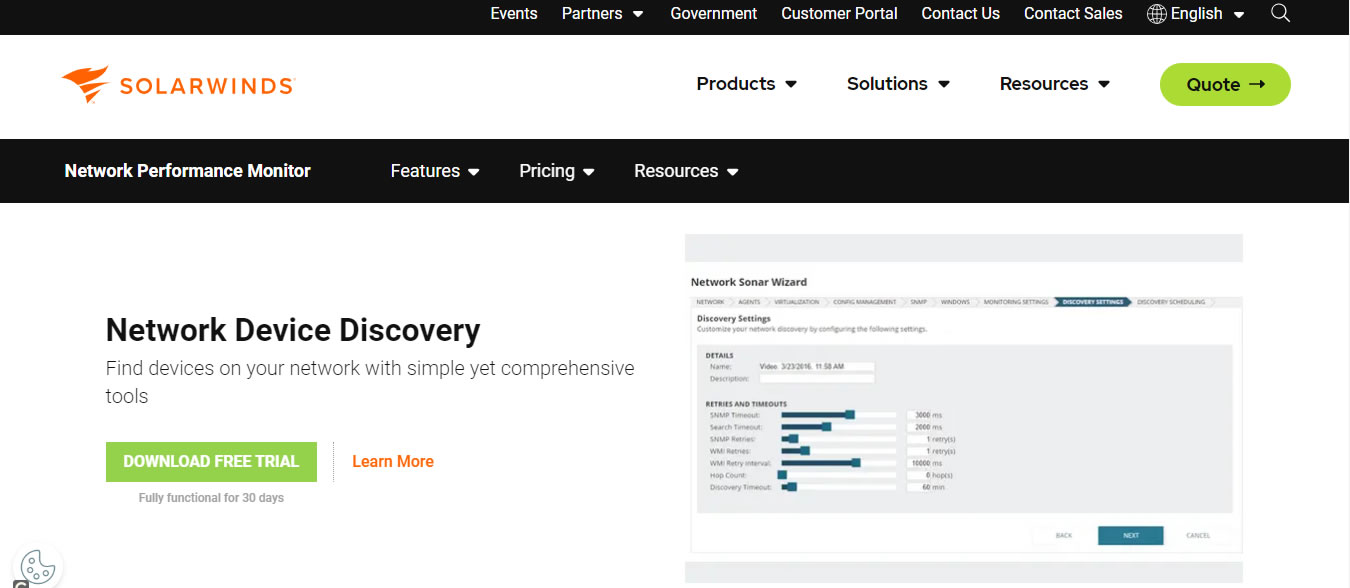
SolarWinds NPM does more than just monitor network performance. It includes a discovery wizard that automatically finds network devices and gathers detailed information about them. Users can easily find devices on the network and create dynamic network maps to visually track performance statistics. The SolarWinds NPM network device discovery tools can also be used to collect metrics to see which devices are in healthy, warning, or critical states.
Key features:
- Automatic device discovery: It automatically discovers network devices and gathers information about them through its integrated discovery wizard tool.
- Device classification: It automatically classifies discovered devices based on their type (routers, switches, servers, etc.). This helps organize your network inventory and simplifies monitoring workflows.
- SNMP-based network device mapping: It offers SNMP monitoring capabilities to automatically map network devices and create dynamic network maps for efficient performance tracking.
- Efficient device scanning: Users can easily scan a range of network devices from a single dashboard using IP addresses, subnets, IP range, or even Active Directory.
Why do we recommend it?
SolarWinds NPM is a compelling choice for organizations seeking a comprehensive network discovery and performance monitoring solution, particularly for large and complex networks. I observed its scalability, customization options, integration capabilities, and all-in-one approach make it a powerful network management tool.
Who is it recommended for?
SolarWinds NPM is recommended for mid-sized and large enterprises, as well as MSPs, that require a feature-rich solution for network discovery, performance monitoring, and troubleshooting within complex network environments.
Pros:
- Improved network visibility: Automated discovery ensures you have a complete picture of your network devices, reducing the risk of overlooking critical components.
- Simplified monitoring setup: Discovered devices automatically populate your SolarWinds inventory, making it easier to set up monitoring for them.
- Active directory integration: Seamless integration with Active Directory simplifies device discovery and management, especially in Windows-centric environments.
Cons:
- Complexity for beginners: While the network discovery module is user-friendly, SolarWinds NPM might seem a bit challenging due to its advanced features and detailed monitoring tools.
4. NetBrain

NetBrain is a network management platform with a robust discovery engine at its core. It automatically discovers and maps your entire network, encompassing traditional IT infrastructure, software-defined elements, and cloud environments, providing a real-time snapshot of your network's health.
Key features:
- Automatic discovery: Automatically discovers all devices within your hybrid network, including on-premise and cloud infrastructure.
- Detailed device information: Gathers comprehensive information about discovered devices, including configuration details, performance metrics, and connectivity data.
- Digital twin creation: Leverages the discovery data to build a dynamic "digital twin" of your network, representing a real-time replica of its entire topology and configuration.
Why do we recommend it?
NetBrain provides a constantly updated view of your network's state, including device health, performance, and traffic flow. I determined that this real-time visibility is crucial for proactive network management and troubleshooting. Its digital twin and network intents empower you to automate various network management tasks, improving efficiency and reducing human error.
Who is it recommended for?
NetBrain is ideal for managing complex hybrid networks with a mix of traditional IT infrastructure, software-defined elements (SDN), and cloud environments, providing real-time visibility and enabling network automation.
Pros:
- Real-time visibility: Provides a constantly updated view of your network inventory, ensuring you have the latest information.
- Proactive problem detection: Identify historical trends and potential issues before they disrupt operations.
- Network automation: Leverage the digital twin and network intents to automate network management tasks.
Cons:
- Features beyond network discovery: For users solely focused on basic network discovery, NetBrain's feature set and cost might be excessive.
5. WhatsUp Gold
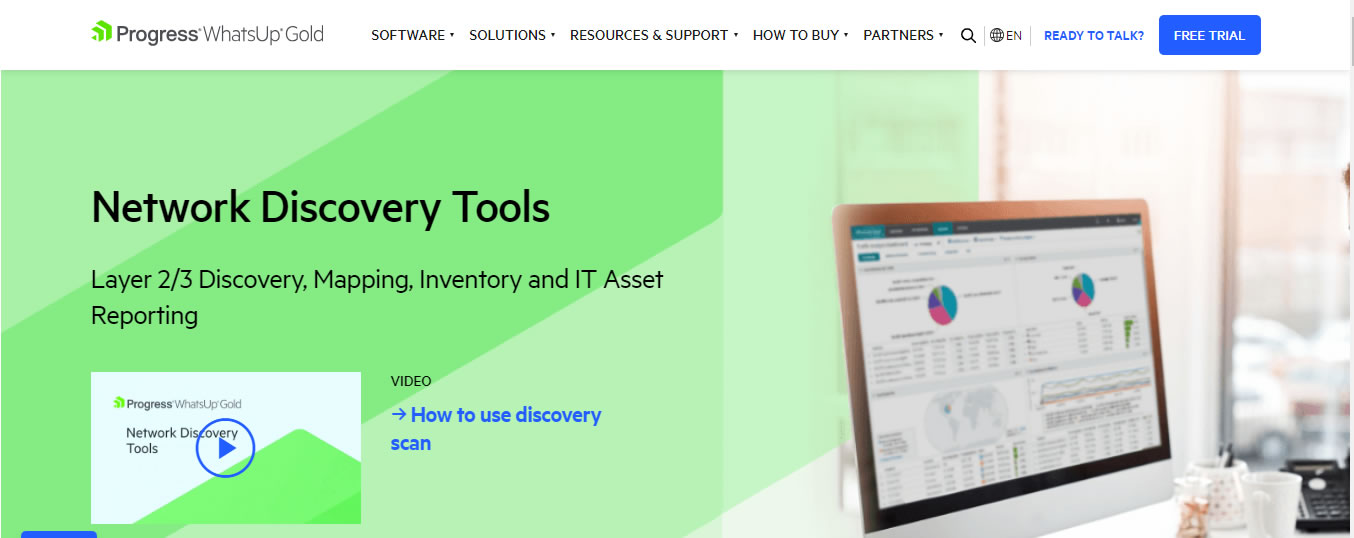
WhatsUp Gold lets you easily find and fix problems in your hybrid cloud using simple processes, system integrations, and unparalleled built-in features. WhatsUp Gold’s network discovery tool, known as Layer 2/3 discovery, monitors and maps everything in your entire networked infrastructure.
Key features:
- Device discovery: Utilizes advanced Layer 2/3 discovery technologies such as ARP, SNMP, SSH, and others to identify all devices connected to your network.
- Network mapping: Automatically generates detailed Layer 2 and 3 network maps, offering insights into physical, logical, and virtual connectivity.
- Network inventory management: Provides comprehensive network inventory and configuration information, supporting internal business processes like ITIL and regulatory compliance requirements.
- Asset management: Enables users to gather, filter, and export a wide range of inventory and configuration data across networking devices and systems.
Why do we recommend it?
A major benefit of WhatsUp Gold is its seamless integration of discovered devices with its network monitoring functionalities. I detected that this eliminates the need for separate tools for discovery and monitoring. Compared to feature-rich network discovery tools, WhatsUp Gold offers a more affordable solution, especially for smaller networks with basic discovery requirements.
Who is it recommended for?
If you're taking the first steps towards network monitoring, WhatsUp Gold's ease of use and bundled discovery functionalities can be a good starting point. Its scalability and feature set are well-suited for SMB IT teams managing less complex network environments.
Pros:
- Device identification: Utilizes multiple discovery technologies, ensuring thorough device identification across the network.
- Detailed network maps: Automatically generates detailed network maps, making it easy for users to visualize network topology and connectivity.
- Efficient asset management: Facilitates efficient management of network assets through data gathering and export capabilities, streamlining asset tracking and documentation processes.
Cons:
- Higher costs for extended infrastructure visibility: Extended visibility into larger infrastructure may incur higher licensing costs.
6. Atera
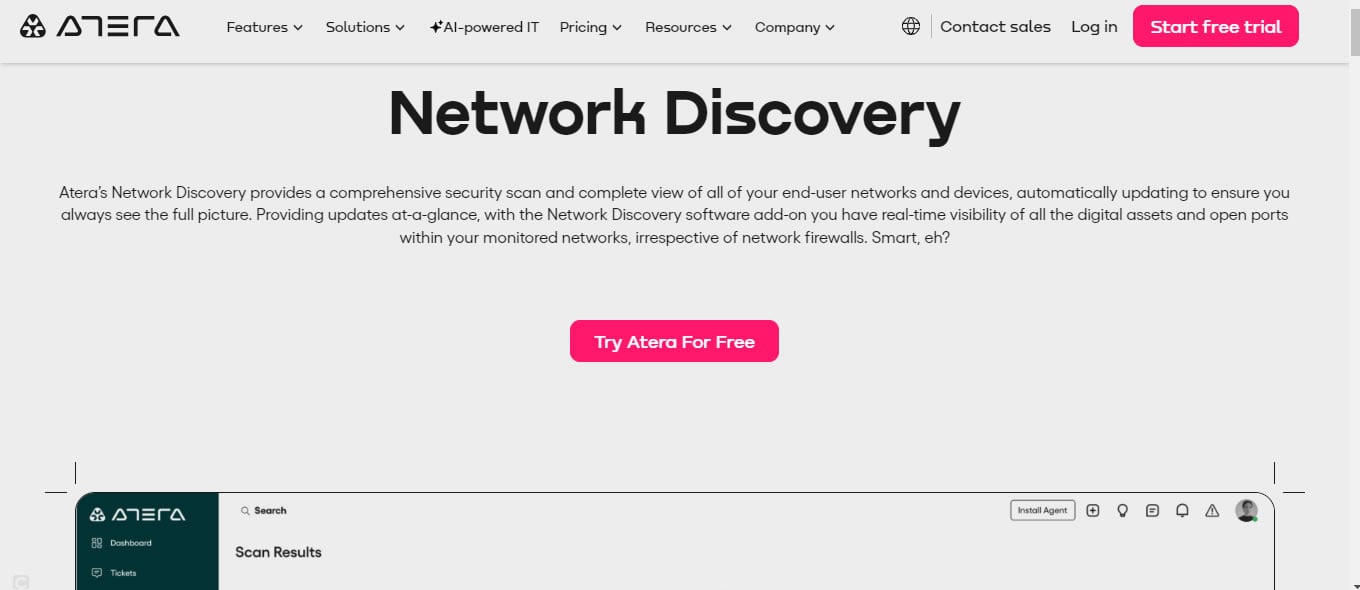
Atera is a cloud-based Remote Monitoring and Management (RMM) platform for managing, monitoring, securing, and troubleshooting various network devices within a centralized location. But Atera isn't just an RMM tool, it comes with a built-in network feature that automatically scans client networks upon installing a lightweight agent on a single device.
Key features:
- Network visualization: Offers dynamic graphs and reports that provide a comprehensive view of IT environments.
- Port scanning: Maps the entire attack surface of a network, scans ports on discovered devices, and eliminates unnecessary open ports.
- Active directory and workgroups scanning: Automatically monitors Workgroup and Domain Controller networks, identifying and listing every asset and component, thereby enhancing visibility.
- Real-time monitoring: Atera continuously monitors the discovered devices, providing real-time insights into their health and performance.
Why do we recommend it?
Atera's network discovery feature conducts thorough scans and offers a complete overview of all end-user networks and devices. I noticed that it updates automatically to ensure you constantly have an up-to-date view. With the Network Discovery software add-on, you get instant updates and real-time visibility of all digital assets and open ports across your monitored networks.
Who is it recommended for?
Atera's network discovery is a valuable tool for IT teams and MSPs seeking to automate client onboarding, gain complete network visibility, and improve overall IT infrastructure management efficiency.
Pros:
- Improved client onboarding: Auto-discovery simplifies the initial setup process for new clients, saving MSPs time and effort.
- Comprehensive network visibility: Atera provides a complete picture of all devices on a client's network, ensuring no critical components are overlooked.
- Enhanced security management: Port scanning helps identify potential security risks, allowing MSPs to take proactive measures.
- Streamlined IT asset management: Centralized inventory management simplifies tracking hardware and software assets across multiple clients.
Cons:
- Atera is an RMM platform: Atera offers a broader set of functionalities beyond just discovery, including remote access, patch management, and service ticketing. This might be unnecessary for those solely focused on network discovery.
7. Fortra Intermapper
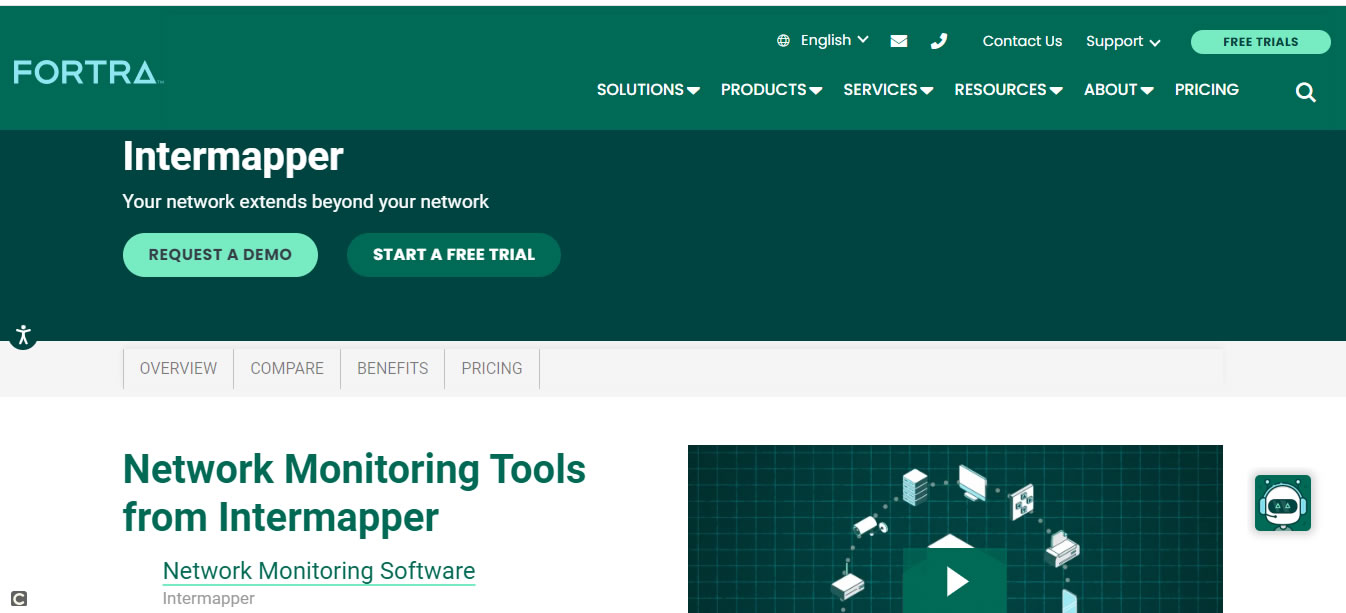
Intermapper is a cross-platform, network monitoring, and network mapping program for Mac, Linux, and Windows. Intermapper automatically discovers devices across your network and then creates dynamic, color-coded network maps that update in real-time, providing a clear visual representation of your network's health.
Key features:
- Automatic network mapping: Quickly discover and document every IP-enabled device on your network within minutes using Intermapper's network mapping software.
- Proactive network monitoring: Continuously monitor all devices, interfaces, servers, and applications 24/7 using SNMP and other protocols to ensure their current status is tracked effectively.
- Robust network management: Utilize advanced features to analyze reports, manage condition acknowledgments, and update alert settings.
- Smart alerting: Receive flexible notifications to alert your team promptly when performance thresholds are exceeded.
Why do we recommend it?
We recommend Intermapper for its unique advantage: automatic discovery and the creation of live, color-coded network maps. I recognized that this visual approach simplifies understanding network topology and device locations at a glance. Intermapper can handle discovery for small to large networks effectively.
Who is it recommended for?
Intermapper is a great choice for organizations who value a clear visual understanding of their network layout and real-time updates. Its user-friendliness and scalability cater to individual network administrators, MSPs managing multiple networks, and any organization that wants to effectively map and monitor their entire distributed IT environment.
Pros:
- Efficient network mapping: Rapidly discover and document network devices, facilitating efficient network management and troubleshooting.
- Continuous monitoring: Provides 24/7 monitoring of devices, interfaces, servers, and applications, ensuring proactive identification of issues and maintaining network health.
- Advanced network management: Offers robust features for analyzing reports, managing alerts, and acknowledging conditions, allowing for effective network management and optimization.
Cons:
- Complexity for novice users: Advanced features may be overwhelming for novice users, requiring time and training to fully utilize the software's capabilities.
8. Nmap

Nmap stands as one of the most renowned and powerful network discovery tools available today. It's an open-source utility that allows users to explore networks, discover hosts, and identify services running on them. Nmap uses raw IP packets to scan networks and analyze responses from devices. This allows it to gather detailed information beyond basic device identification.
Key features:
- Host discovery: Nmap employs various techniques such as ICMP echo requests, TCP SYN scans, and ARP requests to determine which hosts are active.
- Port scanning: Once live hosts are discovered, Nmap can probe them to identify open ports and services.
- Ping scan: Perform host verification by sending ping requests to check for live hosts, helping to confirm the presence of active systems on the network.
- TCP/IP stack fingerprinting: Determine the OS and hardware characteristics of network devices by analyzing network activity observations.
Why do we recommend it?
We recommend Nmap for its ability to provide in-depth network discovery, offering functionalities beyond basic device identification. I found that the combination of its free and open-source nature, customizability, and automation potential makes it a valuable asset, particularly for experienced network administrators and security professionals.
Who is it recommended for?
Nmap is recommended for a variety of users who require in-depth network discovery and analysis, but its technical nature makes it more suitable for those with some networking knowledge.
Pros:
- Comprehensive network discovery: Provides a detailed view of your network devices, services, and potential vulnerabilities.
- Free and open-source: No licensing fees associated with using Nmap, making it a cost-effective solution.
- Highly customizable: Tailor scans to your specific requirements with a wide range of options and commands.
- Portability: Compatible with most operating systems, including Linux, Microsoft Windows, FreeBSD, OpenBSD, Solaris, Mac OS X, and more, ensuring broad accessibility across diverse computing platforms.
Cons:
- Complexity: Nmap can be complex for novice users due to its rich feature set and diverse scanning techniques. Users may need to invest time in learning and mastering its capabilities.
9. Spiceworks
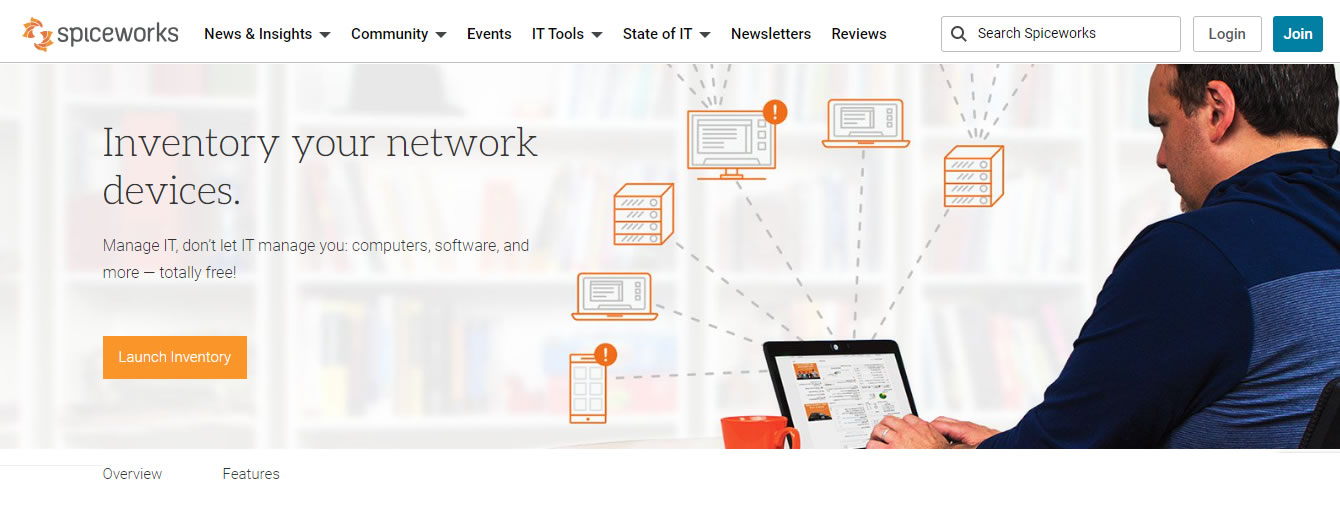
Spiceworks offers a free and user-friendly network discovery tool suitable for smaller networks or those on a tight budget. It automatically scans your network to identify devices like computers, printers, and servers. It then collects basic information about each device, including IP address, MAC address, operating system, and manufacturer.
Key features:
- Device discovery: Automatically scans the network to discover and inventory all connected devices, including computers, servers, printers, switches, and more.
- Inventory management: Once devices are discovered, Spiceworks maintains detailed inventories of each device, including hardware specifications, software installed, network configuration, and more.
- Network monitoring: Spiceworks continuously monitors the health and performance of network devices, alerting administrators to potential issues such as downtime, high resource utilization, or security vulnerabilities.
- Software management: Spiceworks can also track software installations and licenses across the network. This helps organizations stay compliant with software licensing agreements.
Why do we recommend it?
Spiceworks stands out for its free, user-friendly approach to network discovery, making it a valuable tool for smaller networks or those starting with network management. I discovered that the active user community and its focus on basic needs are additional advantages.
Who is it recommended for?
Spiceworks is recommended for smaller networks with a limited number of devices, as it offers a basic yet effective way to gain an understanding of their network inventory. Those new to network management can use Spiceworks as a free entry point to learn about network discovery and basic inventory management.
Pros:
- Free and open-source: Spiceworks is a free and open-source tool, making it a budget-friendly option for smaller networks or personal use.
- Easy to use: The web-based interface is user-friendly and requires minimal configuration, allowing even those new to network discovery to get started quickly.
- Community support: Spiceworks benefits from a large and active user community that provides support and troubleshooting assistance.
Cons:
- Ad supported: Spiceworks free version is supported by advertising, which may be distracting or intrusive for some users. Organizations that prefer an ad-free experience can opt for the paid version of the platform.
10. Open-AudIT

Open-AudIT is an application designed to provide detailed insights into your network infrastructure via automated scans. It identifies all devices connected to your network, understands their configurations, and tracks any changes that occur over time. Open-AudIT is compatible with both Windows and Linux systems, ensuring accessibility across different operating environments.
Key features:
- Network discovery: Open-AudIT scans your network to discover devices like computers, printers, servers, and network appliances.
- Inventory management: Discovered devices are automatically added to a centralized inventory database, allowing you to track hardware and software assets.
- Asset tracking: Tracks assets throughout their lifecycle, from acquisition to decommissioning, providing visibility into asset utilization, location, ownership, and maintenance history.
- Network mapping: Generates visual network maps to illustrate the interconnections between devices and their relationships within the network topology.
Why do we recommend it?
Open-AudIT stands out as a free and open-source network discovery tool that goes beyond basic device identification. I noted that its asset tracking, reporting, and alerting features provide valuable functionalities for network inventory management.
Who is it recommended for?
For network administrators managing networks in smaller businesses or organizations, Open-AudIT offers a good balance of discovery, asset tracking, and reporting functionalities at no cost. The free and open-source nature makes it an attractive option for IT departments with budget constraints.
Pros:
- Free and open-source: Open-AudIT is a free and open-source tool, making it a budget-friendly option for organizations of all sizes.
- Reporting and alerting: Provides valuable insights through reports and alerts, helping you stay informed about your network inventory and potential security risks.
- Scalability: Open-AudIT can scale to handle discovery and management for small to medium-sized networks effectively.
Cons:
- Learning curve: While not as complex as Nmap, setting up and utilizing Open-AudIT effectively might require some learning effort.


Post a Comment Community Rules
You need to login in order to post a comment
Not a member yet? Register Now